Vardin
| Vardin | |||||||||||||||||||||||||
|---|---|---|---|---|---|---|---|---|---|---|---|---|---|---|---|---|---|---|---|---|---|---|---|---|---|
 | |||||||||||||||||||||||||
| Base Information | |||||||||||||||||||||||||
| Classification | Scavenger/Intimidator | ||||||||||||||||||||||||
| Status | Minor Race | ||||||||||||||||||||||||
| Locomotion | Walker | ||||||||||||||||||||||||
| Terrain | Forest | ||||||||||||||||||||||||
| Body Form | |||||||||||||||||||||||||
| Confluence | Non-humanoid | ||||||||||||||||||||||||
| Bio-Identenoid | Insectoid | ||||||||||||||||||||||||
| Size | 160 liters | ||||||||||||||||||||||||
| Weight | 160 kg | ||||||||||||||||||||||||
| Culture | |||||||||||||||||||||||||
| Languages | Native Language | ||||||||||||||||||||||||
| Social Structure | Impersonal Bureaucracy | ||||||||||||||||||||||||
| Technological Epoch | TL:10-12 | ||||||||||||||||||||||||
| Psionic potential | Standard | ||||||||||||||||||||||||
| Origin World | |||||||||||||||||||||||||
| Homeworld location | Vardi (Mavuzog 1410) | ||||||||||||||||||||||||
| UWP | A987899-A
| ||||||||||||||||||||||||
| Primary Star | F5 V K3 VI | ||||||||||||||||||||||||
| Atmosphere | Dense | ||||||||||||||||||||||||
| Off-world presence | Yes | ||||||||||||||||||||||||
| Zoetic individuals | Yes | ||||||||||||||||||||||||
| Source | |||||||||||||||||||||||||
| Reference | Theta Borealis Sector . | ||||||||||||||||||||||||
| Canon | No | ||||||||||||||||||||||||
| Also see | |||||||||||||||||||||||||
The Vardin of Vardi (Mavuzog 1410) are a technologically sophisticated Minor Non-Human Race with a non-humanoid appearance.
- The race occupy a region known as Vardin Space.
- The Vardin are under the subjugation of the Jaibok.
- Many of their worlds have been incorporated into the Korsumug Empire.
Description (Specifications)[edit]
The Vardin are native to the temperate forests of Vardi, their homeworld. They have a thriving technological culture that draws strongly on their racial heritage, time-honored teachings, and firmly held traditions. They have established a number of off-world settlements.
Homeworld[edit]
Vardi, a dense atmosphere, rich world located in Galaxa Subsector of Mavuzog Sector.
- Technically it is a binary world, sharing an orbital barycenter with Orta, its large outer moon.
| Hex | Name | UWP | Trade | System | Stars |
| 1410 | Vardi | A987899-A | Ri Pa Ph | 502 KoEm | F5 V K3 VI |
Vardi orbits Caranar, the system's primary star, at a mean distance of 1.61 AU (240.8 million km) and lies within the habitable zone. It has an orbital period of 1 year 289 days and a rotation period of 26.5 hours. The axial tilt is 23 degrees, giving long winter and summer seasons. Vardi has a diameter of 14,746 km, a density of 5.87 g/cm³, and a surface gravity of 1.22 G. The world is geologically active. Its atmosphere is rated as Dense, with a mean surface pressure of 2.33 bar and a composition of 77% nitrogen (N2), 22% oxygen (O2), and 1% argon (Ar), water vapor (H2O), carbon dioxide (CO2), ozone (O3), neon (Ne) and other trace gases. Approximately 68% of the surface is covered in oceans of liquid water: average tidal ranges exceed 0.3m. Mean surface temperature: 28°C. Vardi retains two satellites: a small vacuum moon named Ronax and a temperate thin atmosphere world named Orta, itself an important farming colony. They orbit at 15 diameters and 25 diameters respectively.
Homeworld Geography & Topography[edit]
A simple map of Vardi showing the oceans and seas, the major landmasses and islands, highland regions, and the large polar icecaps.

Total surface area: 683 million km², Water surface area: 464 million km², Land surface area: 219 million km². There is one large continental landmass called Aratam, two larger subcontinents named Pell and Jenk, and three smaller subcontinents, temperate Suruku, equatorial Chamba, and southerly, ice-capped Munn. There are many large islands and archipelagos and permanent polar icecaps. Much of the land surface area of the world is low-lying. While there are many types of environments and terrain, the land surface of the world is primarily forested. Flora types vary between environmental regions but most have greenish-blue disc-shaped foliage and thick stems.
Physiology[edit]
Vardin are descended from cooperative scavengers native to temperate forest terrain on their homeworld: their ecological niche is defined as "intimidator". They are endothermic walkers classified Bilateral HBS-T-AL-LL-N, with a bony internal skeleton, ichor internal fluids, and a leathery hide and chitinous plates (most notably covering their backs and their lower legs) that provides a degree of armor . They breathe atmospheric oxygen, respirating via four closable spiracles located on the upper torso, below the head. Based on their profile: standard and oversize, the Vardin have a length of around 1.8m and stand around 1.2m tall: they may rear up to a height of more than 2m. An average Vardin weighs around 160kg.
The Vardin body has a vaguely teardrop shape. The lower torso contains the mouth, the digestive tract, and the reproductive organs. The upper torso tapers into a broad flat head and contains the major internal organs. Vardin have eight limbs: three pairs of relatively slender articulated legs emerge from the sides of the lower torso and a single pair of arms are located on the upper torso. The arms terminate in hand-like structures consisting of four mutually opposable digits: the arms are able to reach all parts of the body. The torso is flexible and Vardin may stretch, twist, and curl into a protective ball.
- The mouth is not connected to the respiratory tract. A Vardin cannot breathe through its mouth.
- The mouth is multiply articulated, allowing it to open and close and to move around in order to better position itself above a meal.
- Unless it it intending to feed or attempting to intimidate a target, a Vardin generally keeps its mouth firmly closed.
The head is generally rectangular in shape and sits atop a thick, muscular neck. It holds the brain and mounts the eyes and ears. Its position covers and protects the mouth and the respiratory tract, both located within the torso. It is extremely large compared to that of a human.
- The brain itself is a similar size to the human brain, though it is more dispersed and is protected by a thick bony cranium and external chitinous plates.
- The eyes are large in order to better see in the dim conditions common within their forest homes, and are protected by layers of bone and tissue.
- The resulting extra weight is supported by multiple layers of muscle, itself further adding to the size of the head.
The coloration and patterning of Vardin hides varies along ethnic lines, with the most common shades being mottled greens and blues. Males tend to have narrow darker stripes while females exhibit darker spots and swirls. A few Vardin have small frills of brightly-colored skin located on either side of the head: these can be spread or retracted voluntarily and are often referred to as "ears" by humans, though they serve no aural function. The frills were much larger in ancestral Vardin and acted as a mechanisms both to signal to others and to help scare away rival organisms when claiming a kill. Most Vardin lack this feature.
Image Repository[edit]
Senses[edit]
- Energy: V-12-GBP (eyes, located at the front of the head). Vardin vision is generally parallel to (but slightly poorer than) that of humans. They have good depth perception but limited peripheral vision. Their color perception is shifted towards ultraviolet: they have difficulty seeing shades of red but can perceive near UV.
- Vibration: H-20-A383 (ear-dimples, located on the side of the head). Vardin aural perception is superior to that of humans. They can hear sounds at frequencies from about 16 Hz to 25,000 Hz.
- Volatiles: S-8-2 (nose-pits, located above the mouth). The Vardin sense of smell is slightly poorer than that of humans. However, their taste palette is sophisticated, enabling them to determine the chemical nature of ingested nutrients. All Vardin have a distinctive musky smell.
- Matter: T-04-2 (skin and manipulators). The leathery hide of Vardin is generally insensitive to subtle pressure and sensation, though they can feel harder impacts. Softer areas of skin, such as the hands and the mouth-muzzle located under the torso, are particularly sensitive to texture and temperature.
- Fields: A-0. Unaware.
- Auras: P-0. Unaware.
Characteristics[edit]
- Strength (physical power) 4D (actual 12+2D)
- Dexterity (hand-eye co-ordination) 2D
- Vigor (short-term fatigue resistance) 3D
- Intelligence (ability to think and reason) 2D
- Training (based on cultural heritage) 2D
- Social (large group hierarchy) 1D
Genetic Profile: SDVITS
Movement[edit]
Vardin are forest terrain walkers, evolved to track through woodlands, thickets and dense foliage in search of food. They are rated as Slow, with a typical moving speed of around 5 kph. Vardin may trot for (Vigor x5) minutes at approximately 25 kph and are capable of briefly sprinting for (Vigor x5) seconds at speeds of up to 40 kph. A typical Vardin has a Vigor of 10: they have limited long-term endurance.
- Vardin are buoyant in water but are poor swimmers. They quickly tire, becoming exhausted after (Vigor x1) minutes of swimming.
Reproduction and Lifespan[edit]
Vardin are dual gender (males and females), though there are only minor external differences between the two. Males and females are equal within society, filling identical roles and functions. Males and females form short-lived pairings to exchange genetic material and young Vardin are raised and schooled within communal creches. Generally, young Vardin have no contact with their parents and familial ties within Vardin society are non-existent.
Females bear a single larva weighing less than a kilogram and lacking any extremities a few days after fertilization. The larva makes its way to a dorsal pouch where it attaches to a nipple and grows for the first few months of its life, developing a head and limbs. Once it is capable of independent movement the young Vardin leaves the pouch and joins a communal creche. It continues growing until the end of childhood, at around 6 years, when gender differences begin to take effect. These gender traits continue to develop throughout adolescence until the Vardin reaches maturity, at around the age of 14. A Vardin continues to slowly gain bulk until it reaches its physical peak at around 30 years. The first indications of physical decline begin at around 40 – a typical Vardin will have a lifespan of around 70 years. Some individuals have reached ages in excess of 100 years.
Life Stages[edit]
- 0 Infant (Larva): 2 years.
- 1 Child: 4 years.
- 2 Adolescent: 8 years.
- Career starts at age 14.
- 3 Young adult: 2 terms (8 years).
- 4 Adult: 2 terms (8 years).
- 5 Peak: 3 terms (12 years).
- Physical aging begins (42+ years).
- 6 Midlife: 3 terms (12 years).
- 7 Senior: 2 terms (8 years).
- 8 Elder: 1 term (4 years).
- 9 Retirement: 1 terms (4 years).
- Mental aging begins (70+ years).
A Vardin has a typical lifespan of around 70 years.
Diet and Trophics[edit]
Vardin are defined as scavenger intimidators. They have a preference for fresh meat, small game, insects, and a variety of roots and fruits, but will consume aged meat and other less palatable organics if need arises. Their ancestors gained their nutrition by scaring away predators and taking possession of their kill: modern Vardin practice large-scale agriculture. The Vardin digestive system is very resilient and can tolerate levels of toxins and spoilage in foodstuffs that would seriously endanger the health of other sophonts.
- Vardin "sit on top" of their meal in order to consume it.
- Vardin prefer strongly-flavored foodstuffs.
- Vardin have a reputation as excellent (if unconventional) cooks.
Psychology & Philosophy[edit]
Vardin society is fractious and individual Vardin are endlessly politicking, squabbling, and forming petty alliances in order to further themselves or their interests. Vardin have little regard for status and rank, firmly adhering to the principle that deeds speak louder than words.
Primal Drives[edit]
The Vardin psyche is driven by factors common to many sophonts:
- Acquisition (stemming from the need to gather adequate nutrition),
- Curiosity (originating from the urge to seek out sources of nutrition)
- Preservation (derived from the need to continue their personal existence), and
- Perpetuation (the urge to continue the species).
Behaviors[edit]
A behavioral drive is an instinctual need that has the power to dramatically influence the behaviour of an individual. These drives, derived from and molded by their evolution, strongly influence the mental processes of the Vardin.
Major Drives[edit]
- Confident. Vardin have a strong belief in their own abilities. They have faith in themselves and tend to automatically extend that confidence to others. This relates to their ability to scare or overawe other creatures in their ecological niche as intimidators.
- Introspection. If their actions are shown to be wrong or counterproductive, Vardin can become inward-looking and given to doubt and self-analysis. They may seek social and physical isolation for a short time. Humans refer to this behaviour as "sulking".
- Impatient. Most Vardin lack long-term mental patience and tolerance: those exhibiting self-restraint and inner discipline are admired and looked up to.
- Impetuous. Vardin tend to act without careful consideration of the possible consequences. Their behaviour may be marked by undue haste or a lack of deliberation or caution. A Vardin may exhibit courage or bravery far beyond that of a human simply because they have failed to consider the dangers presented by their course of action.
- Individualistic. Although they are social creatures, Vardin like to think and do things in their own way, rather than imitating others or following perceived social norms. Vardin display a great deal of originality in their thoughts and actions. While Vardin can and do act in unison, they struggle with cohesion in large groups.
Minor Drives[edit]
- Emotional. Vardin are deeply concerned with emotions and feelings. They readily express their feelings and expect others to do the same. This is related to their overall philosophy of "universal one-ness", where all aspects of the individual are shared.
- Honest. Generally, Vardin are honest and straightforward, though individuals of course display unique traits. Vardin have a reputation for being "bad at keeping secrets".
- Sensitive. Vardin are quick to take anger or offense.
- Optimistic. Vardin, as a rule, tend to be hopeful and confident about the future. They tend to assume that the best possible outcome will occur, and hope for it even if it is not likely. This relates to their natural confidence as intimidators.
- Idealistic: Vardin are guided by principles or hopes rather than by practicality. By their nature they tend to be perfectionists.
- Obsessive: Vardin may develop a persistent preoccupation with an often unreasonable idea or concept.
Outlook[edit]
Philosophy: Connectivity. Everything is connected, nothing is disconnected. Nothing in the universe stands by itself. Every object is a link in an endless chain and is thus connected with all the other links. And this chain of the universe has never been broken; it unites all objects and processes in a single whole and thus has a universal character. Secrets and dishonesty are ultimately pointless: in the fullness of time everything will become apparent.
Theology: Vardin embrace the concept of panantheism (everything is god). Reality is identical with divinity, and all things compose an all-encompassing, immanent deity that interpenetrates all aspects of the universe and transcends it.
Ethics: Inner relativism: in any given situation there is a right and a wrong, or a better or worse choice. The individual must determine what that is and act accordingly.
Psychology: Co-effective consciousness, an intuitively perceived knowledge of something within an individual's inner self. The Vardin believe in the concept that everything is inter-connected, and no matter what action is taken it will have effects that ripple out across the universe.
History & Background (Dossier)[edit]
The primal ancestors of the Vardin evolved in the temperate forests of their homeworld around a quarter of a million years ago. A global ice-age and the resulting environmental changes and consequent shortages of food were the likely triggers that pushed them to full intelligence. They gradually spread across the word and by ca. -17,000 the first civilizations began to flourish.
First contact with humans was ca -1900, when Terrans of the Rule of Man, pushing out into the vast wilderness of uncharted space, chanced across their homeworld. Their societies were broadly at TL–1 at the time, but contact with these first explorers and their revelations about the universe triggered a revolution in the Vardin, bringing on an age of science and discovery. Contact ceased during the Long Night but the Vardin continued to advance. By the late 300s, as increasing numbers of Imperials and even a few Zhodani began to enter the sector and contact was reestablished, the Vardin had reached TL–4.
Society & Culture[edit]
- Homogeneity A (Discordant)
- Acceptance B (Extremely friendly)
- Strangeness 5 (Distinct)
- Symbols 6 (Somewhat concrete)
Prior to their homeworld's conquest by the Korsumug Empire, the Vardin lived in small rival nation-states bound together by tradition and economic need. At present, they are governed by a repressive Impersonal Bureaucracy that was imposed upon them by the Jaibok.
Demographics[edit]
Homeworld
Approximately 450 million, divided into three major racial groups:
- Sanka Vardin (65% of the population). Sanka are considered the baseline for the species. They tend to have paler hides with relatively indistinct markings.
- Ennodo Vardin (25% of the population). Ennodo are generally slightly smaller in stature, and have paler hides with heavier markings. They are far more aggressive than other Vardin.
- Kara Vardin (10% of the population). Kara are noticeably larger and have very dark hides. They have a reputation for calmness and wisdom. Kara Vardin often have neck frills (an atavistic feature that all proto-Vardin possessed) and use them to signal mood and intent.
Offworld
Approximately 100 million, almost entirely concentrated on Felspar.
- Only Sanka and Ennodo are likely to be encountered: Kara Vardin very rarely leave the homeworld.
Language[edit]
The primary means of communication is through vocalisation. Sound is created by voluntarily pushing air through the breathing spiracles in the throat. As well as producing modulated tones, Vardin can click, chirp, and whistle and readily use these sounds in their languages. Many of the sounds they use are beyond the range of human hearing.
- A Vardin may simultaneously produce different sounds from different breathing spiracles.
- A great many languages and dialects exist.
Calendar:[edit]
- The local day is 26.5 standard hours in length.
- The local year is 654.5 standard days long.
A local year is divided into 592.75 local days.
- When not on their homeworld, Vardin routinely use standard time metrics.
Timeline of Historical Events[edit]
- ca.250,000 BCE: Proto-Vardin achieve intelligence on Vardi.
- ca.17,000 BCE: the first Vardin civilizations flourish on their homeworld.
- ca.-1900: First human-Vardin contact.
- -1776-0: The Long Night. Offworld contact ceases.
- ca 400: human contact reestablished.
- ca 750: offworld settlements are established. Vardin Space is established.
- ca.950: Jaibok establish a small community on Vardi.
- 978 Vardi is invaded and occupied by the Korsumug Empire.
Astrography[edit]
This race is primarily located in the following areas:
Charted Space:

A simple chart of Vardin Space, a region with significant populations of Vardin.
Homeworld[edit]
The homeworld of this race is:
World Listing[edit]
Significant communities of this race are known to dwell within the following systems and worlds:
References & Contributors (Sources)[edit]
- Bill Bledsaw. Theta Borealis Sector (Group One, 1981), .
- Author & Contributor: Lord (Marquis) and Master Scout Emeritus Adie Alegoric Stewart of the IISS
- Author & Contributor: Lord (Marquis), Captain, and Lead Naval Architect Ronald B. Kline, Jr. of the Imperial Navy

